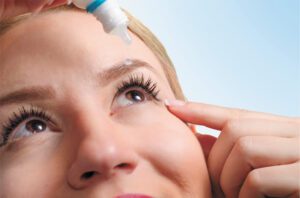By Dr. Kate Wagner, board-certified optometrist and managing partner at Elmquist Eye Group


Studies show dry eye symptoms can impact quality of life with inability to concentrate at work, irritability and limitations on activities, all which can affect emotional well-being. Living with dry eyes can be debilitating and disheartening for many people.
An estimated 55 million Americans have dry eye disease, the most under-diagnosed ocular disease, but the most common reason patients go to see their eye doctor.
Our eyes need the right amount of tear production for the eye’s surface to stay moist, smooth and our vision clear. Tears work by spreading a layer made of oil, water and mucus over the surface of the eye, removing dirt and debris. Dry eyes occur when the eyes do not produce enough or the right type of tears.
Dry eye syndrome (DES) is an ocular surface disease that can affect quality of vision and overall eye comfort. Typical symptoms range from mere itching and tearing to a burning sensation, or even feeling like there is a rock in your eye. It may seem odd, but dry eyes also often cause watery eyes. The watering is a response to the irritation.
People tend to make fewer tears as they get older due to hormonal changes, particularly after menopause for women. Other causes include certain conditions such as diabetes, rheumatoid arthritis, Sjogren’s syndrome, thyroid disease, Parkinson’s disease, rosacea, previous eye surgery and lupus. Dry eyes are also a symptom of dehydration.
Certain environments can also increase dry eyes, including smoke, wind or a dry climate. Activities that reduce blinking, including looking at screens for a long time and reading can dry out eyes. Certain medicines like diuretics, beta-blockers, allergy and cold medicines, sleeping pills, anxiety and antidepressant medicines and heartburn medicines are also linked to dry eyes.
Tears protect the surface your eyes from infection. If left untreated, severe dry eyes may lead to eye inflammation, abrasion of the corneal surface, corneal ulcers and in extreme cases vision loss.
Consider these tips for addressing mild symptoms of dry eye:
• Use artificial tears. Available without a prescription, artificial tears help lubricate the eyes and maintain moisture. Prescription eye drops are also available.
• Practice the 20/20/20 rule. Every 20 minutes take a 20-second break and look at something at a distance of 20 feet or more when working on a screen.
• Blink often. Blinking brings a fresh layer of tears to your eyes, so make a conscious effort to blink often and fully.
• Clean your eyelids. At the end of the day, gently clean your eyelids with a mild cleanser to remove bacteria and traces of eye makeup.
• Wear sunglasses. Protect your eyes from harmful UV rays as well as dust and wind that can further contribute to dry eyes.
• Evaluate your medications. Some medicines can make dry eye symptoms worse. Your doctor can review your current list of medications and determine if an alternative prescription may help.
• Drink plenty of water. The body’s response to loss of fluid is to conserve water, including a lack of tear production.
If symptoms of dry eyes are persistent, an ophthalmologist or optometrist can help identify the proper course for treatment. A comprehensive eye exam can determine whether the symptoms you are experiencing are related to dry eyes.
Other tools available to diagnose this common condition include the TearLab Osmolarity test, which detects the severity of dry eye syndrome in order to determine the best treatment. Using a painless procedure that takes seconds to perform, a tear sample is taken for testing that is smaller than the period at the end of a sentence. The test measures the osmolarity (saltiness) of tears. The higher the saltiness, the more surface cells can become damaged.
Another method to treat dry eye includes conserving tears, which keeps natural tears in the eye longer. Tears drain out of the eye and into the nose through a small channel, called the tear duct. It is possible to close those tear ducts either temporarily or permanently, helping conserve your tears and make artificial tears last longer.
You don’t need to suffer – dry eye syndrome is treatable. If you are concerned you may have dry eyes, contact Elmquist Eye Group.
Kate Wagner, O.D.
With more than 25 years of service to the Southwest Florida community, Elmquist Eye Group offers experienced doctors who are dedicated to patient care. Dr. E. Trevor Elmquist, Dr. Kate Wagner, Dr. Sarah Eccles-Brown, Dr. Nina Burt and Dr. Yasaira Rodriguez of Elmquist Eye Group are available to answer your questions. With three U.S. military veterans leading the practice, Elmquist Eye Group’s team stands ready to serve you right here in Southwest Florida. For more information, visit www.Elmquist.com, call 239-936-2020 or stop by an Optical Boutique location in Fort Myers or Cape Coral.
Elmquist Eye Group
239-936-2020
www.elmquist.com
FORT MYERS
7970 Summerlin Lakes Dr.
CAPE CORAL
2336 Surfside Blvd., Suite 121
 Southwest Florida's Health and Wellness Magazine Health and Wellness Articles
Southwest Florida's Health and Wellness Magazine Health and Wellness Articles

